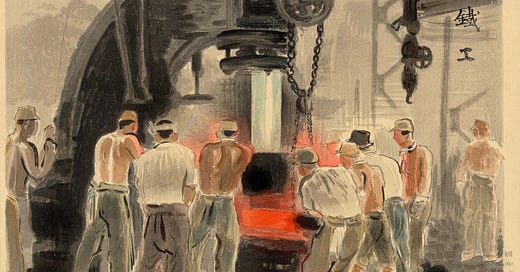Inside the New Productivist Economy
Introducing Value Added, a newsletter about the political economy of innovation.
We are living amidst a broad economic transition, a shift that economist Dani Rodrik has described as the “new productivist paradigm.” The path we’re leaving behind—neoliberalism—is clear, but what lies ahead and whether it will endure is less certain. Still, some trends are emerging. Faith in markets is waning, and governments are stepping up as key economic actors. Globalization is being replaced with regional revitalization. New emphasis is being placed not on the consumer but on the worker.
This economic transition should not be mistaken as a Keynesian revival. Its focus is not explicitly on redistribution and managing aggregate demand but on creating new development opportunities by transforming the supply side of the economy, most of all firms, and how firms produce. Indeed, the fundamental change at the heart of this broader economic transition is how we organize production, beginning with what we choose to produce. This transformation is already underway. New emphasis is being placed on productive investments over finance and platform-based activities. Services-led growth, touted as a new growth engine for developing and developed countries alike, is now giving way to a resurgence in manufacturing.
Many external factors have contributed to this economic transition, from the climate crisis to escalating U.S.-China rivalry. However, the core driver of this transformation comes from within the system itself—neoliberal production has failed for the majority of people in advanced economies. Over the past 40 years, production patterns have shifted away from productivity-enhancing technologies and good jobs, focusing instead on cost-cutting, labor squeezing, and offshoring rather than investments that drive productivity. With the rise of ICT technologies and financialization, extractive—rather than productive—strategies have also become just as effective at profit generation. These patterns of production have major distributional implications, resulting in many of today’s most urgent challenges—inequality, economic exclusion, and job insecurity. If these problems stem from the production decisions made under neoliberalism, then the solution must begin with transforming how we produce.
Value Added is about the challenges and opportunities of this transformation. In it, I plan to explore topics such as:
State intervention and industrial policy
How incumbents of the neoliberal era may resist change
Corporate strategies and firm structures needed for this productivist ambition
Industrial transformation for green and equitable growth
How platform capitalism/knowledge-based services fit into a productivist future
These topics can be explored from various perspectives. In Value Added, my approach—at least starting out—will emphasize the following dimensions. First, Value Added places firms at the center of its analysis. It is interested in how firms, as organizations, learn and how their success depends on their ability to coordinate effective relationships. These relationships can be internal, involving their employees, or external, involving suppliers/clients, collaborators, business associations, unions, or the government. Additionally, this newsletter will view firms through the lens of important national institutional structures such as competition law, labor relations, and corporate governance.
Second, and as already hinted at, Value Added takes the issue of labor seriously. Normally, labor conditions are analyzed to understand the distributional aspects of a particular production regime. However, what’s often overlooked is that these conditions can also significantly impact economic performance. Whether a firm competes on price and labor costs (the “low road”) or on quality and skilled labor (the “high road”) carries critical implications.1 The low road may deliver higher short-term returns, but the high road builds more resilient firms that are not only better equipped to navigate uncertainty and rapid change but also contribute to a stronger, more sustainable economy—one in which good jobs play a vital role in fostering long-term success. The key question, and a central focus of Value Added, is understanding what conditions enable high-road production.
Finally, Value Added embraces development economics as its intellectual guide. First, under the premise that markets in developing economies are prone to failure, the field has long embraced state intervention as a necessity for growth. Second, the challenges that developing countries have long grappled with—labor market dualism, limited productive capabilities, and a shortage of high-quality, productivity-enhancing jobs—are now also pressing concerns in developed economies. Finally, the question of how to build productive capacities has been central to development economics since the field’s inception in the 1940s and 1950s. From infant industry protection to the heavy-handed industrial policies of the East Asian developmental states, the development literature offers valuable historical foundations for navigating this broader economic transition.
Whether a productivist economic transition will endure and whether it will bring the profound changes that many anticipate remains to be seen. But, if Trump’s second victory signals anything, it’s that the widespread frustration with neoliberal production runs deep—that the pressures compelling this broad economic transition are here to stay. Our challenge—and what Value Added aims to do—is to study this transition so we can identify the levers for building an economy that’s resilient, inclusive, and truly sustainable.
Streeck, W. 2004. “Educating Capitalists: A Rejoinder to Wright and Tsakalotos.” Socio-Economic Review 2(3): 425–38. doi:10.1093/soceco/2.3.425




